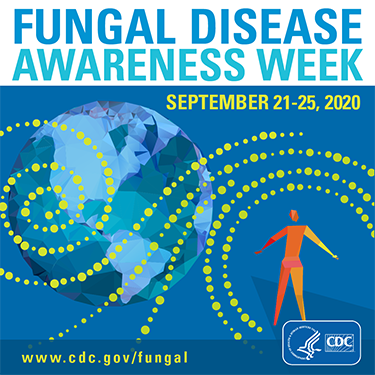Fungal Infections - Protect Your Health

Here are 10 questions you can use to understand fungal infections and know what you need to do to stay healthy.
Fungi are everywhere. Sometimes, they are too small to see with the naked eye. Fungi can live outdoors in soil and on plants; indoors on surfaces and in the air; and on people’s skin and inside the body. There are millions of fungal species, but only a few hundred of them can make people sick.
Mild fungal skin infections can look like a rash and are very common. For example, ringworm is a skin infection caused by a fungus—not a worm! Fungal infections in the lungs can be more serious and often cause symptoms that are similar to other illnesses, such as the flu or tuberculosis. Fungal meningitis and bloodstream infections are less common than skin and lung infections but can be life-threatening.
Because the symptoms of fungal infections can be similar to those of other illnesses, proper diagnosis and treatment are often delayed. The more you know about fungal infections and your chances of getting one, the better you can protect your health.
Learn more about whether you are at risk of getting a fungal infection by reviewing these 10 questions.
- Where do you live and travel? Fungi that can cause serious infections are more common in some parts of the United States and world. For example, the fungus that causes Valley fever (also called coccidioidomycosis) is found mainly in the southwestern United States. Histoplasmosis and blastomycosis occur most often in the eastern United States. These infections usually cause a lung infection that is often mistaken for flu or a bacterial pneumonia.
- What types of activities are you doing? Harmful fungi can be found in air, dust, and soil. Histoplasma grows especially well in soil that contains bird or bat droppings. During activities like digging, gardening, cleaning chicken coops, and visiting caves, you could inhale fungi that may cause infection.
- Do you have a dog or cat? People can get ringworm from their pets. Dogs and cats with ringworm sometimes have circular, hairless patches on their skin or other types of rashes. Adult animals do not always show signs of ringworm infection.
- Have you recently taken antibiotics? Antibiotics can make women more likely to get vulvovaginal candidiasis, also known as a vaginal yeast infection. Women who are pregnant or those who have weakened immune systems also are more likely to get this condition. Men also can get genital candidiasis.
- Are you taking any medicine that affects your immune system? Medicine used to treat conditions like rheumatoid arthritis or lupus may weaken your immune system and increase the chance of getting a fungal infection.
- Are you living with HIV/AIDS? People living with HIV/AIDS (particularly those with CD4 counts less than 200) may be more likely to get fungal infections. Two well-known fungal infections associated with HIV/AIDS in the United States are oral candidiasis (thrush) and Pneumocystis pneumonia. Worldwide, cryptococcal meningitis is a major cause of illness in people living with HIV/AIDS.
- Are you going to be hospitalized? In the United States, one of the most common bloodstream infections in hospitalized patients is caused by a fungus called Candida. Candida normally lives in the gastrointestinal tract and on skin without causing any problems, but it can enter the bloodstream during a hospital stay and cause infection.
- Have you recently had a transplant? People who have recently had an organ transplant or a stem cell transplant have a greater chance of developing a fungal infection since their immune systems are weakened. Doctors prescribe antifungal medicine for some transplant patients to prevent fungal infections from developing.
- Are you receiving chemotherapy or radiation treatments? Cancer treatment, such as chemotherapy and radiation, weakens your immune system and thus may increase the chance you will get a fungal infection.
- Do you have symptoms of pneumonia that are not getting better with antibiotics? Fungal infections, especially lung infections like Valley fever, histoplasmosis, and aspergillosis, can have similar symptoms as bacterial infections. However, antibiotics don’t work for fungal infections. Early testing for fungal infections reduces unnecessary antibiotics use and allows people to start treatment with antifungal medicine, if necessary.
Join CDC in sharing information to increase awareness in your community about fungal diseases during Fungal Disease Awareness Week, September 21-25, 2020.

Estimated areas with blastomycosis, coccidioidomycosis (Valley fever), and histoplasmosis
This map shows CDC’s current estimates of where the fungi that cause blastomycosis, coccidioidomycosis (Valley fever), and histoplasmosis live in the environment in the United States. These fungi are not distributed evenly in the shaded areas, might not be present everywhere in the shaded areas, and can also be outside the shaded areas.
Anyone can get a fungal infection, even people who are otherwise healthy. People breathe in or come in contact with fungal spores every day without getting sick. However, in people with weak immune systems, these fungi are more likely to cause an infection. You can learn more about the signs, symptoms, and treatment of fungal infections and get prevention tips by visiting CDC’s fungal diseases website and by talking with your healthcare provider.























.png)











No hay comentarios:
Publicar un comentario